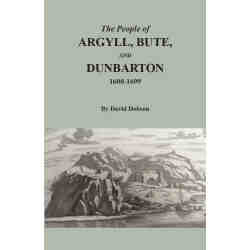This book concentrates on the people of Argyll, Bute, and western Dunbartonshire during the seventeenth century. This region lies on the west coast of Scotland between the Firth of Clyde in the south to the Sound of Arisaig and Lochiel in the north. By the seventeenth century it was in the hands of Clan Campbell and the Earls of Argyll. This area was originally known as Dalriada, where the Scots from Ireland settled in the Dark Ages; it also includes Dunbarton (the fort of the Britons), a small British kingdom bordering the Firth of Clyde.
Most family names found in this book were of Gaelic origin. Clans traditionally located in this region were the Campbells, Lamont, McIntyres, McGregors, McEwan, McCorquadale, McMillan, Malcolms or MacCallums, McLachlan, and Macleans.
During the seventeenth century, Scotland was subjected to several wars and rebellions. The Campbells of Argyll were prominent Presbyterians, and their clansmen opposed the forces of King Charles I of England; however, the king’s execution and the establishment of the English Republic by Oliver Cromwell was rejected north of the border. In response, Cromwell brought an army to Scotland and defeated the Scots at Dunbar in 1650. Charles II of Scotland sought to replace Anglicanism with Presbyterianism in England, and on that basis leaders such as the Earl of Argyll, with his men, joined the king’s invasion of England and were defeated at the Siege of Worcester in 1651.
In 1685 the Earl of Argyll raised an army from among his tenantry and kin in rebellion against King James II of England (James VII of Scotland), which was defeated on 27 May 1685. After this failure, the Earl was executed, many of his followers were captured, and some were transported in chains for sale in the Americas and the West Indies.
This book is largely based on documents located in the National Records of Scotland in Edinburgh, including those of the Argyll Sheriff Court, church records, the Register of the Privy Council of Scotland, sasines (property records), deeds, and military rolls. This work provides evidence of seventeenth-century links from Argyll with Ireland, Nova Scotia, New England, New Jersey, Jamaica, and Barbados. These early links led to significant emigration to Jamaica and North Carolina in the eighteenth century.


